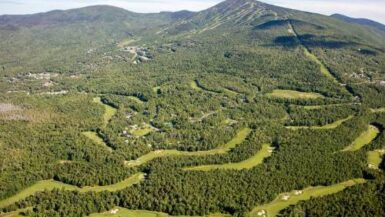RED TAIL GOLF CLUB
Devens, MA
978.772.3273
www.redtailgolf.net
Architect: Brian Silva
Par – 72
Excitement Level – 9/12
Diff. – 6/12
Conditioning – Four and ½ stars
Cost – $90 peak, $50 reduced
Yearly Memberships – Yes, $4,250 play anytime
$3,250 play M-Th
Value – Four and ½ stars
Overall – Four and ½ stars
Tees Yards Rating Slope
Tournament 7006 73.9 138
Regular 6379 70.5 130
Senior 5654 67.7 119
Forward 5049 69.4 120
In the past ten years public golf in the greater Boston area has flourished. Hometown architect Brian Silva is one important reason why. Silva not only builds interesting designs wherever he goes, he has proven himself a master of several different genres of course design featuring a seemingly inexhaustible wealth of strategic design features. From his first neo-classic gem at Waverly Oaks to his wonderfully authentic Links at Hiawatha Landing (designed with partner Mark Mungeam), Silva has proven creative, versatile, and progressive. Most importantly, Silva courses are wonderfully inexpensive and impeccably manicured.
In the heart of the birthplace of the American Revolution, Red Tail Golf Club (Devens, MA) is just thirty miles from downtown Boston and a mere drive and 8-iron from Lexington and Concord, where valiant minutemen fought and died to shape the destiny of the free world.
Red Tail combines classical parkland style with random and strategic waste bunkering thrown in for good measure in a neo-classic masterpiece. Silva’s trademark sculpted bunkering defines otherwise wide fairways through rolling hills. The course features good alternating shots (e.g. fade off the tee, draw into the green), and has a good variety of shot shaping requirements off the tee. Most importantly, at $90 in high season and $50 at twilight, it’s one of Boston’s most affordable tracks.
Red Tail surpasses all expectations. Every hole is memorable, except perhaps the short par-4 12th and no holes or holes that seem forced or over the top. Four sets of tees offer a fair test to golfers of all skill levels without the player feeling overmatched.
Contoured, slick slivers of greens guarded by fiendish drop offs into Donald Ross-like collection areas defend par well on the short par fours and frequently feature what one Red Tail course ranger described as “Sunday pin placements every day.” Finally, as every round at a Silva course is also a lesson in classical golf architecture features, players will negotiate punchbowl greens, saddle greens, modified Redans and hazards turned perpendicular to the line of play in the manner of Silva’s idols, Seth Raynor and C. B. Macdonald.
The front nine may be one of the best outward nines on the entire eastern seaboard. While many architects wish to offer an easy warm up at the first, Red Tail demands crisp contact and concentration on the first drive of the day – an intimidating cross bunker cuts obliquely across the fairway and must be carried to reach the landing area. Further, the shot plays over a natural hump, adding elevation to the challenge. Fade off the tee, but draw into the green, the player is required to exact various shot shapes right out of the gate.
The second showcases an original Silva design feature, the “Green Monster bunker,” a veritable pancake stack of multi-layered bunkers guarding the left side of the landing area of this dog leg right par five. (Two other examples of a mountain-like Green Monster stack of bunkers on top of one another are found at the par-5 ninth at Links at Hiawatha Landing and the par-5 fourth at Silva’s private version of Red Tail, Black Rock Golf Club in nearby Hingham.)
The third is a gorgeous modified Redan par-3 which plays uphill to a deep green. Take enough club to reach comfortably as the fairway slopes severely to the right and shots short or right will result in an awkward uphill 40 yard pitch to the putting surface. Players can take advantage of Silva’s intentionally designed “kick slope” short and left of the green to bounce the ball onto the green and take advantage of the hole’s natural contours to feed the ball to the hole. (There is another “secret slope” on the left side of the seventh green as well. “Shh…don’t let the secret out too much” Silva says with a grin.)
Silva loves punchbowl greens (see also # 11 at Hiawatha Landing) and gives us two at Red Tail. The first is at the uphill, yet reachable par-5 fourth. Better players can use the green’s natural contours to spin the ball to the day’s hole location for an eagle try.
The stretch of six through nine features a short-long-short-long combination of stellar par-4s. The sixth features the prettiest drive of the day, a long carry over a ravine with water left and trees right. The lake off to the left offers an idyllic view, but do not be distracted from the demanding drive at hand. The eighth measures a scant 306 from the Regular Tees, but the green is a mere sliver and slopes off dangerously on all sides. Chip shots here are every bit as dicey as at fabled Pinehurst No. 2.
The par-5 tenth is listed as the hardest hole on the card and may live up to its reputation. Bending hard to the left, climbing uphill all the way, and lined by trees on both sides which make the playing area particularly narrow, one misplayed shot will damage any chance for a par. The beautiful par-3 eleventh plays from an elevated tee to an elevated green set at the base of a steep hill. Shots short or right will either find a penal bunker or require a 40-50 yard uphill chip to a small green. Again, Silva leaves one side clear for short-knockers to bump and run their way safely to the green.
The finish is creative and memorable. After a beautiful drive from an elevated tee at the 400 yard 14th, the approach is uphill to a saddle green, more steeply sloped than its front side sister. 17 is the most popular hole with the players. From an elevated tee box, the cape-style hole begs for a long drive cutting the corner on this dog leg right. However, shots short or right find a waste bunker that looks straight out of Pine Valley or World Woods. “I deliberately made the contours round and did not provide a target off the tee because the challenge there is for the player to choose the right line” notes Silva. The hole is a strategic masterpiece and has been repeatedly voted the best hole in the Greater Boston Area.
Finally the 18th is a reachable par-5 for the long hitter who can carry the crest of a hill, but the second shot will be played from an uneven lie (at best) to a green fronted by water. The entire fairway slopes toward the water, so even third shot approaches with wedges need to be precise. A front right pin position often suckers in greedy, imprudent players and hangs a round crushing big number if played carelessly.
Players of all skill levels equally love Red Tail for its beauty, fairness and inexpensive price tag. While swinging a “speed stick” in the parking lot of Pinehurst at the 2005 U.S. Open, Boston pro James Driscoll took the time to offer public golf travel tips. “I played Red Tail in the New England Amateur one year and all the players loved it. It’s more modern than many of the old Donald Ross courses and it’s in great condition. I especially liked its cool design features. It has great character.”
A registered member of the Audubon International Signature Cooperative Sanctuary, Red Tail features diverse flora and fauna, including deer and the red tail hawks for which the course takes its name. Ever the historians, locals are as equally proud of the site’s heritage as the former site of the Fort Devens military base as they are of the rich colonial pedigree. General George Patton taught tank maneuvers on course land and before course building could begin the course was thoroughly searched for old munitions. Several old shells and hand grenades turned up. In fact, the storied history of the site and the need to protect the environment actually had a positive affect on Silva’s design. Silva was not allowed to remove the slab foundations of the old fort housings, so holes 2 though 8 and number 10 were built over the top of these foundations.
Luckily for Silva, he was able to use the natural flow the fairway followed over these subterranean structures to fit the shot shaping requirements he had designed for the holes. Two great examples are the draw receptive fairways at 8 and 10. “How about that!” Silva beams, “I was forced into certain parameters by site considerations and environmental limitations and it came out great. I probably would not have imagined that hole had the outside factors not been imposed on my work.” Perhaps that is also the hallmark of a world-class designer – making lemonade when the world hands you lemons.
Great architects want to experiment. Like Strantz, Silva is intrepid and gleefully rips the rug out from under player’s expectations. Like Dye he is fearless. And like Raynor he is true to the game’s roots and employs a broad and deep bag of design features. He is neo-classic, taking the old for a canvas and boldly brushing it with new strokes. As such, he is both reflective upon the old and spontaneous, challenging us in two ways. First, we grow to accept novel or revived design features. Second, by learning about golf design we play better.
Silva has a unique, highly personal voice; an important and well respected one. But most importantly and interestingly, he has a world class sense of Architectural Echo. He takes old design features like redans and punchbowls and brings them into the 21st century. Also, his designs resonate from the time they are built with little diminishment in respect or popularity. .
A truly great travel destination either changes the traveler forever or validates one of the traveler’s long-held beliefs. A great round of golf does the same. Silva validates two critical concepts for golf and golfers. First, we are living in the golden age of architecture, building the best courses now and only getting better, more imaginative, and more intrepid. Second, we should not be afraid of changing what the mainstream accepts as “a golf course.”
Golf is not a game of perfect, but golf is also not a game of easy. From punchbowls to pancake stack bunkers, from a Biarritz to a Redan, with designers like Silva at the vanguard grateful golfers will get so much more than just another vanilla flavored tree-lined target course. After all, there may be countless beautiful golf courses in the world, but the strategic subtleties that often go unnoticed are the real test of the enduring greatness of a golf course.




Leave a reply
You must be logged in to post a comment.